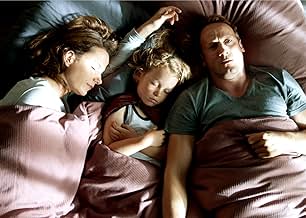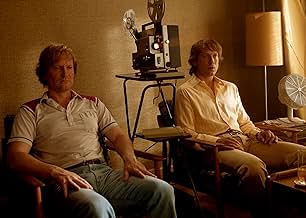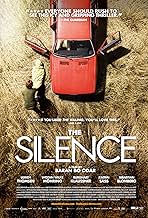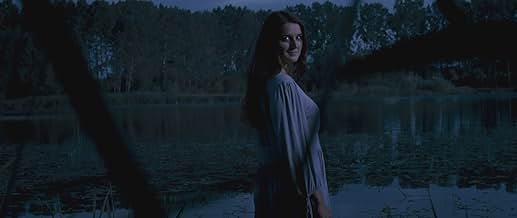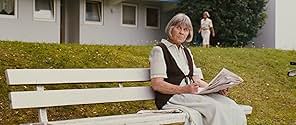NOTE IMDb
6,9/10
8,6 k
MA NOTE
Ajouter une intrigue dans votre langue13-year-old Sinikka vanishes on a hot summer night. Her bicycle is found in the exact place where a girl was killed 23 years ago. The dramatic present forces those involved in the original c... Tout lire13-year-old Sinikka vanishes on a hot summer night. Her bicycle is found in the exact place where a girl was killed 23 years ago. The dramatic present forces those involved in the original case to face their past.13-year-old Sinikka vanishes on a hot summer night. Her bicycle is found in the exact place where a girl was killed 23 years ago. The dramatic present forces those involved in the original case to face their past.
- Réalisation
- Scénario
- Casting principal
- Récompenses
- 1 victoire et 4 nominations au total
Amon Wendel
- Malte
- (as Amon Robert Wendel)
Lena Klenke
- Sinikka
- (as Anna-Lena Klenke)
Helene Luise Doppler
- Pia
- (as Helene Doppler)
Avis à la une
Baran bo Odar's film begins almost wordlessly on a sunny day in 1986. Two men driving along in a red car (Ulrich Thomsen, Wotan Wilke Möhring) encounter a young girl riding a bicycle (Helene Doppler). They pursue her into a cornfield where one of the men rapes her, kills her with a blow to the head and dumps her corpse in an adjacent lake.
Fast forward to 2009, and one of the two men (Möhring) has become a successful architect, married with two children, while the other (Thomsen) works full-time as a caretaker. The memory of that traumatic occasion haunts both of them, creating a complicated web of lies, deceit and implication that leads to the murder of another young girl (Anna-Lena Klenke).
The film's title not only refers to the silence practiced by the perpetrators of the original crime in 1986, but also describes other people's state of mind. For twenty-three years the murdered girl's mother (Katrin Sass) has kept silent about her harrowing ordeal; likewise the police inspector (Burghart Klaussner) who was involved in the original investigation but failed to achieve a result. It is only after this lengthy time-lapse that they decide to come out and voice their feelings, as well as trying to reconcile themselves to what happened in the past.
Shot in garishly bright colors (by Nikolaus Summerer) creating a world of apparently endless summer weather that nonetheless appears highly dystopian, THE SILENCE offers an insight into the pedophile mind, which often thinks it is doing nothing wrong, even while taking a perverted pleasure in watching child porn videos. The film also takes a look at the ways in which such people are allowed to flourish in societies that prefer to turn their collective backs on such unpleasant issues in the belief that everyone is fundamentally well-intentioned. bo Odar's film proves precisely the opposite; it is often the outwardly most respectable people that prove the most dangerous.
Fast forward to 2009, and one of the two men (Möhring) has become a successful architect, married with two children, while the other (Thomsen) works full-time as a caretaker. The memory of that traumatic occasion haunts both of them, creating a complicated web of lies, deceit and implication that leads to the murder of another young girl (Anna-Lena Klenke).
The film's title not only refers to the silence practiced by the perpetrators of the original crime in 1986, but also describes other people's state of mind. For twenty-three years the murdered girl's mother (Katrin Sass) has kept silent about her harrowing ordeal; likewise the police inspector (Burghart Klaussner) who was involved in the original investigation but failed to achieve a result. It is only after this lengthy time-lapse that they decide to come out and voice their feelings, as well as trying to reconcile themselves to what happened in the past.
Shot in garishly bright colors (by Nikolaus Summerer) creating a world of apparently endless summer weather that nonetheless appears highly dystopian, THE SILENCE offers an insight into the pedophile mind, which often thinks it is doing nothing wrong, even while taking a perverted pleasure in watching child porn videos. The film also takes a look at the ways in which such people are allowed to flourish in societies that prefer to turn their collective backs on such unpleasant issues in the belief that everyone is fundamentally well-intentioned. bo Odar's film proves precisely the opposite; it is often the outwardly most respectable people that prove the most dangerous.
THE SILENCE is a German murder mystery that's heavily indebted to two separate sources: firstly, the whole look and mood of the currently-popular Scandinavian cop shows (such as THE KILLING), from which the style of music is frequently ripped off (like that whole thing with a single, deep note held for a while). Meanwhile, the plot and police investigation bear more than a hint of the exceptional South Korean drama, MEMORIES OF MURDER.
What follows is predictable but occasionally highly gripping, and strangely enough different sub-plots in the movie have different levels of interest. I admit that I found the whole police investigation to be pretty dull; there isn't actually much investigating taking place, and it all seems very slow and stately. The scenes of grieving parents are so familiar by now that they didn't affect me at all.
A second, alternate part of the film follows the friendship between two men, one of whom is a paedophile and murderer. This part of the film is exceptionally, dealing with dodgy subject matter in an intensely gripping way. Ulrich Thomsen (from THE THING remake) and Wotan Wilke Mohring are both very good here, and I would have much preferred the whole film to concentrate on these two by doing away with the predictable police stuff altogether. However, what we're left with is a real film of two halves; one's powerful stuff indeed, and the other's best forgotten.
What follows is predictable but occasionally highly gripping, and strangely enough different sub-plots in the movie have different levels of interest. I admit that I found the whole police investigation to be pretty dull; there isn't actually much investigating taking place, and it all seems very slow and stately. The scenes of grieving parents are so familiar by now that they didn't affect me at all.
A second, alternate part of the film follows the friendship between two men, one of whom is a paedophile and murderer. This part of the film is exceptionally, dealing with dodgy subject matter in an intensely gripping way. Ulrich Thomsen (from THE THING remake) and Wotan Wilke Mohring are both very good here, and I would have much preferred the whole film to concentrate on these two by doing away with the predictable police stuff altogether. However, what we're left with is a real film of two halves; one's powerful stuff indeed, and the other's best forgotten.
Most murders are committed by people who know their victim, a fact that is standard fare in most whodunits. Rarely are murders committed at random, although the recent horrific thriller Funny Games (1997, remade 2007) presents the worst possible scenario.
But random murders do occur in real life: all over the world, people disappear and forever remain 'dead' with family and friends who are forever in limbo, unable to achieve closure. Only sometimes are the perpetrators caught.
With that thematic background, The Silence presents just that scenario with the rape and murder of a young female teen that remains on the books of the local police for 23 years – until it happens again to another teen, on the same day of the year, at the same place, and with the same modus operandi.
Unlike other serial killer movies – for example, The Silence of the Lambs (1991) – we know the identity of the killer from the get-go. Moreover, we also immediately know there are two perpetrators, although one of them is obviously reluctant to participate, even passively as he watches. As the two criminals, Ulrich Thomsen (as Peer Sommer) and Woltan Mohring (as Timo Friedrich) give strong and believable performances that center upon their individual but similar proclivities for depravity: brave actors both to take on such abhorrent roles.
But why a gap of 23 years? Well, that's where the story really starts, after we see the first murder in the first five minutes. And when the second murder occurs, so also occurs the retirement party for the local police detective (Krischan Mittich played by Burghart Klaussner) who failed to solve the first; so also the return to duty of an eccentric, grieving, widowed officer (David Jahn played by Sebastian Blomberg) who is obviously still distraught by the loss of his wife (to cancer) and who engages in bizarre activity; and so also the emotional awakening of the mother of the first murdered teen (Elena Lange played by Katrin Sass), who has been locked in unrelenting grief for over twenty years.
And in that mix there is repressed and introverted Timo – now a successful architect, beautiful home, lovely wife, two munchkins, the works – who, when he reads about the second murder, knows immediately who it is and decides something must be done But, what?
As the police investigate, and as the clues are revealed, the net – so to speak – tightens without the two miscreants knowing. But, as viewers, we know it all, and gradually we move to the edge of our seat as we see how the wrong decisions are made, how the wrong inferences are drawn, how actions by one can be misconstrued by another all too easily, and ultimately how facts can be ignored or discarded for political expediency or professional jealousy and for the need to close a case, once and for all.
Arguably, suspenseful story doesn't get much better than this; although some viewers might argue about narrative holes and coincidence. However, because it's so believable it's so much better, especially the ending which I'm sure many – maybe most – viewers will not see coming, including me. Only in the last thirty seconds, perhaps when the full irony hits you between the eyes.
The setting is semi-rural, ordinary and faultless; the production is well paced, even at two hours; the dramatic acting – there is absolutely no comic relief – is flawless; and the direction is so good, well, a glance or look truly is more effective than a thousand words. The background music is appropriate but, at times, borders on clichéd, I think. However, this is a movie I'll watch again – not only for the story but also for the narrative structure that combines so many different threads of lives shattered by indifference, inaction, inadequacy or inconsolable sadness.
Highly recommended.
November 2011.
But random murders do occur in real life: all over the world, people disappear and forever remain 'dead' with family and friends who are forever in limbo, unable to achieve closure. Only sometimes are the perpetrators caught.
With that thematic background, The Silence presents just that scenario with the rape and murder of a young female teen that remains on the books of the local police for 23 years – until it happens again to another teen, on the same day of the year, at the same place, and with the same modus operandi.
Unlike other serial killer movies – for example, The Silence of the Lambs (1991) – we know the identity of the killer from the get-go. Moreover, we also immediately know there are two perpetrators, although one of them is obviously reluctant to participate, even passively as he watches. As the two criminals, Ulrich Thomsen (as Peer Sommer) and Woltan Mohring (as Timo Friedrich) give strong and believable performances that center upon their individual but similar proclivities for depravity: brave actors both to take on such abhorrent roles.
But why a gap of 23 years? Well, that's where the story really starts, after we see the first murder in the first five minutes. And when the second murder occurs, so also occurs the retirement party for the local police detective (Krischan Mittich played by Burghart Klaussner) who failed to solve the first; so also the return to duty of an eccentric, grieving, widowed officer (David Jahn played by Sebastian Blomberg) who is obviously still distraught by the loss of his wife (to cancer) and who engages in bizarre activity; and so also the emotional awakening of the mother of the first murdered teen (Elena Lange played by Katrin Sass), who has been locked in unrelenting grief for over twenty years.
And in that mix there is repressed and introverted Timo – now a successful architect, beautiful home, lovely wife, two munchkins, the works – who, when he reads about the second murder, knows immediately who it is and decides something must be done But, what?
As the police investigate, and as the clues are revealed, the net – so to speak – tightens without the two miscreants knowing. But, as viewers, we know it all, and gradually we move to the edge of our seat as we see how the wrong decisions are made, how the wrong inferences are drawn, how actions by one can be misconstrued by another all too easily, and ultimately how facts can be ignored or discarded for political expediency or professional jealousy and for the need to close a case, once and for all.
Arguably, suspenseful story doesn't get much better than this; although some viewers might argue about narrative holes and coincidence. However, because it's so believable it's so much better, especially the ending which I'm sure many – maybe most – viewers will not see coming, including me. Only in the last thirty seconds, perhaps when the full irony hits you between the eyes.
The setting is semi-rural, ordinary and faultless; the production is well paced, even at two hours; the dramatic acting – there is absolutely no comic relief – is flawless; and the direction is so good, well, a glance or look truly is more effective than a thousand words. The background music is appropriate but, at times, borders on clichéd, I think. However, this is a movie I'll watch again – not only for the story but also for the narrative structure that combines so many different threads of lives shattered by indifference, inaction, inadequacy or inconsolable sadness.
Highly recommended.
November 2011.
'The Silence' is a dour, multi-perspective thriller, telling the story of a murder investigation and its links to another killing twenty years before. The film effectively conveys a strong sense of a contemporary German environment, making the mundane seem very particular, but somehow the whole thing doesn't quite gel: there are too many points of view to make the viewer care about any one, and the mystery depends on an unlikely motive, with a deliberately inscrutable ending. For me the real problem came in the scene where two policemen fight over the hunch that one of them has: it's just not convincing that either of them would care so much. It's a rare case, in my opinion, of a movie that might have benefited from just a little Hollywood showmanship.
When the bicycle of a 13-year-old Sinikka is discovered in the exact same wheat field where a heinous murder/rape took place 23 years prior, retired police detective Krischan senses that the two crimes are connected, and vows to bring the killer to justice. The fact that Krischan was unable to catch the killer two decades prior still haunts him to this very day, but perhaps with the help of ambitious young officer David, this time he will find a way to bring closure to the case. Later, as the investigation begins and a sweltering summer heat wave washes over the town, the young victim's parents begin to experience an overwhelming sense of dread concerning a clean cut husband and father who had recently visited their home.
This slow-paced thriller is stunning by all means. The characterization is very well done and cinematography is amazing showing the semi-rural countryside of Germany, the camera angles are fantastic explaining many things about the characters.
The narration is amazing because it has so many ends to tie and agony of the characters has been portrayed impeccably. The direction is watertight; everything is well placed and told significantly.
An original thriller from Swiss born Baran bo Odar, kudos to him.
Recommended to quality cinema lovers.
8/10
This slow-paced thriller is stunning by all means. The characterization is very well done and cinematography is amazing showing the semi-rural countryside of Germany, the camera angles are fantastic explaining many things about the characters.
The narration is amazing because it has so many ends to tie and agony of the characters has been portrayed impeccably. The direction is watertight; everything is well placed and told significantly.
An original thriller from Swiss born Baran bo Odar, kudos to him.
Recommended to quality cinema lovers.
8/10
Le saviez-vous
- AnecdotesDirector Baran bo Odar has said that South Korean movie Memories of Murder (2003) was a big inspiration for this movie.
- GaffesAt the start of the TV interview the clock in the control room counts up to 21:40:11 until a cut. Several short scenes later the same clock is shown, again counting up to 21:40:11.
- Bandes originalesPia
written & produced by Michael Kamm, Kris Steininger (as Pas de Deux)
Meilleurs choix
Connectez-vous pour évaluer et suivre la liste de favoris afin de recevoir des recommandations personnalisées
- How long is The Silence?Alimenté par Alexa
Détails
Box-office
- Budget
- 2 300 000 € (estimé)
- Montant brut aux États-Unis et au Canada
- 100 214 $US
- Week-end de sortie aux États-Unis et au Canada
- 7 992 $US
- 10 mars 2013
- Montant brut mondial
- 416 675 $US
- Durée1 heure 58 minutes
- Couleur
- Mixage
- Rapport de forme
- 2.35 : 1
Contribuer à cette page
Suggérer une modification ou ajouter du contenu manquant

Lacune principale
What is the French language plot outline for Il était une fois un meurtre (2010)?
Répondre



